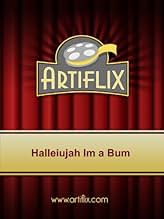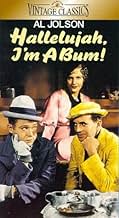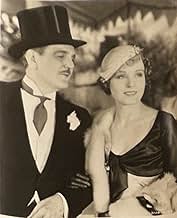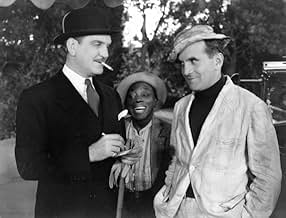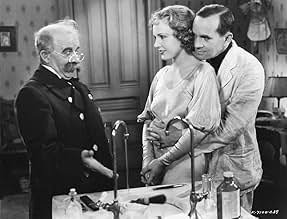Ajouter une intrigue dans votre langueA New York tramp (Jolson) falls in love with the mayor's amnesiac girlfriend after rescuing her from a suicide attemptA New York tramp (Jolson) falls in love with the mayor's amnesiac girlfriend after rescuing her from a suicide attemptA New York tramp (Jolson) falls in love with the mayor's amnesiac girlfriend after rescuing her from a suicide attempt
Ernie Adams
- Man Thrown out of Apartment Building
- (uncredited)
Vince Barnett
- Assistant
- (uncredited)
Ted Billings
- Bum with Violin
- (uncredited)
Heinie Conklin
- Bum
- (uncredited)
Gino Corrado
- Mayor's Chef
- (uncredited)
John George
- Bum
- (uncredited)
Harold Goodwin
- Len
- (uncredited)
Avis en vedette
A bum named Bumper and his pals named Acorn and Egghead live a pleasant life in New York with a philosophy that it is better to be a bum than to work for a living. They just happen to be acquaintances with the mayor of New York who is a bit of a playboy.
When the mayor and his lady friend have a quarrel, she despairs and jumps off a bridge to end her life. Bumper happens to see her jump and rescues her from the river. The result of her trauma is that she has temporary amnesia, and she falls in love with Bumper while he is taking care of her.
This is a charming film, with many attributes that make it commendable. "Hallelujah, I'm a Bum" is first and foremost a musical with some drama and comedy added in. Al Jolson's voice and singing are simply wonderful and this movie is good enough to see for the songs alone. The songs are snappy and cheery and if you'd like to be introduced to the famous Al Jolson, this is a good choice. There is also quite a bit of rhythm and rhyme to much of the dialogue in the film which is unique and fascinating. The credits on the film for 'Songs and Musical Dialogue' go to one of the most famous teams of songwriters in the history of film, Richard Rodgers and Lorenz Hart. Their musical brilliance is in evidence in this film.
The cinematography is very good, and it takes us back to 1933 with a 'feel' for what the atmostphere would have been to be bum living in a park in New York, albeit a very happy go lucky bum in a very idealistically happy world. Lewis Milestone, who directed the film is an extremely well known director from the 1930's and 1940's and his skill is evident here.
Al Jolson is a great fit for his role in this movie as the good natured bum, Bumper. His friends Egghead (Harry Langdon) and Acorn (Edgar Connor) are also delightfully cast; these two actors light up the screen anytime they are present. Harry Morgan is terrific as the mayor (He would later be immortalized as the wizard in 1939 in "The Wizard of Oz." Madge Evans is beautiful as the rejected girl friend of the mayor.
This movie is just plain fun to watch and to listen to. I think you might be surprised to find out that this is one of the early 'talking films' which may still have appeal for many film lovers today. There is something timeless about "Hallelujah, I'm a Bum" which makes it well worth watching. I give it a 9/10.
When the mayor and his lady friend have a quarrel, she despairs and jumps off a bridge to end her life. Bumper happens to see her jump and rescues her from the river. The result of her trauma is that she has temporary amnesia, and she falls in love with Bumper while he is taking care of her.
This is a charming film, with many attributes that make it commendable. "Hallelujah, I'm a Bum" is first and foremost a musical with some drama and comedy added in. Al Jolson's voice and singing are simply wonderful and this movie is good enough to see for the songs alone. The songs are snappy and cheery and if you'd like to be introduced to the famous Al Jolson, this is a good choice. There is also quite a bit of rhythm and rhyme to much of the dialogue in the film which is unique and fascinating. The credits on the film for 'Songs and Musical Dialogue' go to one of the most famous teams of songwriters in the history of film, Richard Rodgers and Lorenz Hart. Their musical brilliance is in evidence in this film.
The cinematography is very good, and it takes us back to 1933 with a 'feel' for what the atmostphere would have been to be bum living in a park in New York, albeit a very happy go lucky bum in a very idealistically happy world. Lewis Milestone, who directed the film is an extremely well known director from the 1930's and 1940's and his skill is evident here.
Al Jolson is a great fit for his role in this movie as the good natured bum, Bumper. His friends Egghead (Harry Langdon) and Acorn (Edgar Connor) are also delightfully cast; these two actors light up the screen anytime they are present. Harry Morgan is terrific as the mayor (He would later be immortalized as the wizard in 1939 in "The Wizard of Oz." Madge Evans is beautiful as the rejected girl friend of the mayor.
This movie is just plain fun to watch and to listen to. I think you might be surprised to find out that this is one of the early 'talking films' which may still have appeal for many film lovers today. There is something timeless about "Hallelujah, I'm a Bum" which makes it well worth watching. I give it a 9/10.
Slap-happy musical film that tries to use music and images together to meld a new format -- and ends up entertaining and likeable. Many of the songs are "recited" in operatic fashion, as when Jolson, the "Mayor of Central Park" (a famous bum) sings his case in court against a singing tribunal that he's been brought before on chargest of betraying his office by taking a job at a bank. A wonderful tracking shot introduces his job through sucessive levels of importance, beginning with high rollers and ending up with lyricist Lorenz Hart telling a customer he doesn't have a dime to give him. After we see all the varying levels of importance in the bank, we finally come on Jolson and his friend, doing the banking equivalent of peeling potatoes. Wonderful charm of Jolson and Langdon is dulled slightly by Morgan and Evans' stiff leads.
Rodgers music and Hart's lyrics are splendid, making this one of the most original, best written original musicals of all time. It should be noted that in his years later working with Oscar Hammerstein, Rodgers only wrote one original play for film (excluding the televised "Cinderella") -- "State Fair" -- which in my opinion, though charming, has got nothing on "Hallelujah, I'm a Bum!" After the failure of this and several other Rodgers/Hart film projects, the duo returned to Broadway to become almost its only reliably successful writers in the later 30s. They left behind this little Hollywood gem to be rediscovered.
Rodgers music and Hart's lyrics are splendid, making this one of the most original, best written original musicals of all time. It should be noted that in his years later working with Oscar Hammerstein, Rodgers only wrote one original play for film (excluding the televised "Cinderella") -- "State Fair" -- which in my opinion, though charming, has got nothing on "Hallelujah, I'm a Bum!" After the failure of this and several other Rodgers/Hart film projects, the duo returned to Broadway to become almost its only reliably successful writers in the later 30s. They left behind this little Hollywood gem to be rediscovered.
This upbeat depression era musical features Broadway sensation Al Jolson as hobo king Bumper. Living in Central Park he and his followers choose a life of leisure to wage slavery debating it in song and rhyme with among others a Red grounds keeper. Even though he's a confidant of the mayor he prefers his laid back lifestyle to patronage work. One night Bumper saves a woman who throws herself off the Bow Bridge. Stricken with amnesia she takes up with Bumper who falls hard enough for her to get a job. When Bumper's "Angel" get's her memory back things change and Bumper returns to his previous vocation.
By 1933 massive unemployment stretched across the land and I can only imagine what the audience reaction of the time might be regarding a musical that extols the joy of joblessness. Jolson's popularity was on the wane having been supplanted by Bing Crosby but he still had enough draw in his voice to make Hallalueh, I'm a Bum a moneymaker and the flimsy story written with sly subversiveness by Ben Hecht does have a light satiric humor to it.
Edgar Conor as sidekick Acorn and silent film clowns Harry Langdon and Chester Conklin add to the film's amiability while Madge Evans as the amnesiac retains a sinewy seductiveness in an evening gown she wears for days on end. Director Lewis Milestone adds his usual camera movements with a striking tableaux here and there but there is also some sloppy back projection and pedestrian editing that gives the finished product a rushed feel. Overall though Hallalueh, I'm a Bum is an oddly interesting take on tough times featuring a legendary talent in fine form.
By 1933 massive unemployment stretched across the land and I can only imagine what the audience reaction of the time might be regarding a musical that extols the joy of joblessness. Jolson's popularity was on the wane having been supplanted by Bing Crosby but he still had enough draw in his voice to make Hallalueh, I'm a Bum a moneymaker and the flimsy story written with sly subversiveness by Ben Hecht does have a light satiric humor to it.
Edgar Conor as sidekick Acorn and silent film clowns Harry Langdon and Chester Conklin add to the film's amiability while Madge Evans as the amnesiac retains a sinewy seductiveness in an evening gown she wears for days on end. Director Lewis Milestone adds his usual camera movements with a striking tableaux here and there but there is also some sloppy back projection and pedestrian editing that gives the finished product a rushed feel. Overall though Hallalueh, I'm a Bum is an oddly interesting take on tough times featuring a legendary talent in fine form.
I'm not much of a fan of musicals but have always been partial to the stylish, sophisticated and sometimes dazzlingly experimental examples of the genre that emanated during the early years of Talkies - the Lubitsch films, Rouben Mamoulian's LOVE ME TONIGHT (1932) and also the delightful French films of Rene' Clair.
To these I can now add this Al Jolson vehicle directed by one of the great exponents of American cinema (at his best during the 1930s, though he continued to work steadily till 1962). This was only my 3rd Jolson film - not counting THE JOLSON STORY (1946), the first of two biopics made while he was still living!; the others were his history-making debut THE JAZZ SINGER (1927), the pioneering Sound picture, and ROSE OF WASHINGTON SQUARE (1939) - actually, his penultimate film, by which time he had been relegated to supporting roles!
Anyway, the film under review here is something of an oddity in that, not only does it present such humdrum fare as the Great Depression through the eyes of a cheerful tramp and his 'colleagues', but it also makes use of rhyming dialogue (whch in the trailer included on the DVD is ballyhooed as a new fad, but it obviously couldn't last!) which was perhaps intended as a natural lead into the songs; in fact, rather than by official screenwriter S.N. Behrman (adapting a Ben Hecht story), these lines were written by lyricist Lorenz Hart! Unfortunately, however, the print utilized for the MGM/UA DVD is quite battered with the soundtrack coming off rather muffled as a consequence!!
Still, its essential quality remains intact: while the plot may seem dated and even fanciful today (both its romanticized view of unemployment and the hero's eventual decision to 'reform' on account of a woman), atmosphere and characterization are as charming as ever: Jolson, dubbed by his cronies "The Mayor Of Central Park" truly comes off as larger-than-life here, but he's matched by the great Silent comedian Harry Langdon (in his only notable Talkie role) - as one of Jolson's pals, a politically-savvy street-cleaner named Egghead(!) who's picked on by the other tramps because he has a job - and Frank Morgan as the real Mayor of New York (whose life Bumper, the Jolson character, had saved during a protest).
The film also involves a three-way romance between Jolson, Morgan and lovely leading lady Madge Evans: she's the latter's girlfriend but, having incurred his distrust, leaves him intent on committing suicide; she's saved by Jolson and, now an amnesiac, Evans is cared for by him who, in order to pay the rent of her new lodgings, even asks his friend Morgan for a job in a bank!; however, noticing Morgan's own concern about his missing girlfriend, Jolson tries to console him...until he realizes just who she is, after which he decides to re-unite the two of them and himself goes happily back to a life on the streets!
Many films have dealt with the theme of the Great Depression but this one's certainly its most original treatment while also being, along with the marvelous screwball comedy MY MAN GODFREY (1936), one of the very best.
To these I can now add this Al Jolson vehicle directed by one of the great exponents of American cinema (at his best during the 1930s, though he continued to work steadily till 1962). This was only my 3rd Jolson film - not counting THE JOLSON STORY (1946), the first of two biopics made while he was still living!; the others were his history-making debut THE JAZZ SINGER (1927), the pioneering Sound picture, and ROSE OF WASHINGTON SQUARE (1939) - actually, his penultimate film, by which time he had been relegated to supporting roles!
Anyway, the film under review here is something of an oddity in that, not only does it present such humdrum fare as the Great Depression through the eyes of a cheerful tramp and his 'colleagues', but it also makes use of rhyming dialogue (whch in the trailer included on the DVD is ballyhooed as a new fad, but it obviously couldn't last!) which was perhaps intended as a natural lead into the songs; in fact, rather than by official screenwriter S.N. Behrman (adapting a Ben Hecht story), these lines were written by lyricist Lorenz Hart! Unfortunately, however, the print utilized for the MGM/UA DVD is quite battered with the soundtrack coming off rather muffled as a consequence!!
Still, its essential quality remains intact: while the plot may seem dated and even fanciful today (both its romanticized view of unemployment and the hero's eventual decision to 'reform' on account of a woman), atmosphere and characterization are as charming as ever: Jolson, dubbed by his cronies "The Mayor Of Central Park" truly comes off as larger-than-life here, but he's matched by the great Silent comedian Harry Langdon (in his only notable Talkie role) - as one of Jolson's pals, a politically-savvy street-cleaner named Egghead(!) who's picked on by the other tramps because he has a job - and Frank Morgan as the real Mayor of New York (whose life Bumper, the Jolson character, had saved during a protest).
The film also involves a three-way romance between Jolson, Morgan and lovely leading lady Madge Evans: she's the latter's girlfriend but, having incurred his distrust, leaves him intent on committing suicide; she's saved by Jolson and, now an amnesiac, Evans is cared for by him who, in order to pay the rent of her new lodgings, even asks his friend Morgan for a job in a bank!; however, noticing Morgan's own concern about his missing girlfriend, Jolson tries to console him...until he realizes just who she is, after which he decides to re-unite the two of them and himself goes happily back to a life on the streets!
Many films have dealt with the theme of the Great Depression but this one's certainly its most original treatment while also being, along with the marvelous screwball comedy MY MAN GODFREY (1936), one of the very best.
Hallelujah, I'm a Bum is the only film Al Jolson did in which he eschewed his blackface completely. He should only have done it earlier and stuck to it.
This film was an experiment in something the producers call "rhyming dialog" Today I think it would be called rap. Audiences didn't really take to it in 1933, but today's audience would probably appreciate it more.
A knowledge of history would help. Until the summer of 1932, New York City had a mayor who was something of a ladies' man whose favorite nightspot was a nightclub right in Central Park. It hasn't been there since the late thirties, Tavern on the Green is a poor substitute. Mayor James J. Walker's favorite dining spot was the Central Park Casino. And many homeless and jobless lived in Central Park in their own makeshift city as the recent film Cinderella Man so aptly demonstrated to today's audience.
Frank Morgan before he became typecast as Mr. Befuddlement is the Mayor of New York. And Al Jolson is the unofficial mayor of Central Park. Through a chain of circumstances they both become involved with the same girl, Madge Evans.
Rodgers and Hart wrote two songs in addition to the rhyming dialog, the title song and You Are Too Beautiful. The latter is a nice romantic ballad that Jolson delivers well. Later on in the 1940s both Bing Crosby and Frank Sinatra had primo versions of this song as well.
In Great Britain the film was released as Hallelujah I'm a Tramp because in the British Isles, the word bum has a different connotation.
It's an enjoyable film today if you can catch it by all means do so.
This film was an experiment in something the producers call "rhyming dialog" Today I think it would be called rap. Audiences didn't really take to it in 1933, but today's audience would probably appreciate it more.
A knowledge of history would help. Until the summer of 1932, New York City had a mayor who was something of a ladies' man whose favorite nightspot was a nightclub right in Central Park. It hasn't been there since the late thirties, Tavern on the Green is a poor substitute. Mayor James J. Walker's favorite dining spot was the Central Park Casino. And many homeless and jobless lived in Central Park in their own makeshift city as the recent film Cinderella Man so aptly demonstrated to today's audience.
Frank Morgan before he became typecast as Mr. Befuddlement is the Mayor of New York. And Al Jolson is the unofficial mayor of Central Park. Through a chain of circumstances they both become involved with the same girl, Madge Evans.
Rodgers and Hart wrote two songs in addition to the rhyming dialog, the title song and You Are Too Beautiful. The latter is a nice romantic ballad that Jolson delivers well. Later on in the 1940s both Bing Crosby and Frank Sinatra had primo versions of this song as well.
In Great Britain the film was released as Hallelujah I'm a Tramp because in the British Isles, the word bum has a different connotation.
It's an enjoyable film today if you can catch it by all means do so.
Le saviez-vous
- AnecdotesHallelujah, I'm a Bum (1933), retitled The Heart of New York, was the first Hollywood feature film to be shown on regularly scheduled USA television. It was broadcast by W2XBS, New York City, on 5 July 1939, two months after their inauguration of regular service which had begun on 30 April 1939 with the opening of the New York World's Fair. It is one of over 200 titles in the list of independent feature films made available for television presentation by Advance Television Pictures announced in Motion Picture Herald 4 April 1942. At this time, television broadcasting was in its infancy, almost totally curtailed by the advent of World War II, and would not continue to develop until 1945-1946.
- GaffesA cameraman's arm is reflected in the partially opened window of the Mayor's limousine when the Mayor meets Bumper at the casino.
- Autres versionsA re-dubbed and edited version (for UK release) called "Hallelujah, I'm A Tramp" frequently turns up on television. In this version the soundtrack is momentarily erased whenever the word 'bum' is sung!
- ConnexionsFeatured in The All Talking, All Singing, All Dancing Show (1973)
Meilleurs choix
Connectez-vous pour évaluer et surveiller les recommandations personnalisées
Détails
- Date de sortie
- Pays d’origine
- Langue
- Aussi connu sous le nom de
- Hallelujah I'm a Tramp
- Lieux de tournage
- Pacific Palisades, Los Angeles, Californie, États-Unis(Central Park scenes)
- sociétés de production
- Consultez plus de crédits d'entreprise sur IMDbPro
- Durée1 heure 22 minutes
- Couleur
- Rapport de forme
- 1.37 : 1
Contribuer à cette page
Suggérer une modification ou ajouter du contenu manquant

Lacune principale
By what name was Hallelujah I'm a Bum (1933) officially released in India in English?
Répondre
